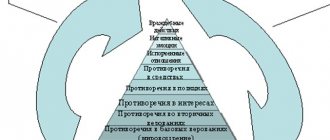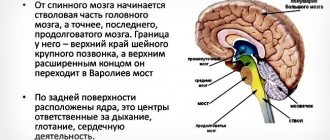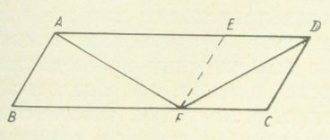What is it: definition of the concept
Emotions - from the Latin “emoveo” means “to excite”, “to excite” - this is an expression of how a person relates to a certain current situation, and how he manifests himself at the moment of experiencing some life event.
Emotions come in two forms - objective - a person experiences certain feelings, his mental and physical state changes (the pulse may increase, breathing and facial expressions may change) and subjective - directly personal internal experiences about the current situation (feelings, thoughts, experiences).
The golden mean - our advice
And as always, a certain average “normality”, beyond which rebellious youth so loves to break out, turns out to be the most optimal remedy for both a heart attack at 40 and clinical boredom at the same time. Because everything is good in moderation. To successfully maintain an average level of emotionality, you need to make friends with emotions.
- First, understand that sensitive emotionality is not an extraneous element that has overwhelmed your life, it is you yourself. Just as you control your arm or leg, you can control your mental state, except in rare cases when emergency processes are triggered.
- As soon as you understand this, sign up for any self-development courses that include emotion training.
- If you don't know which courses to choose, choose an acting school for adults. You can determine the direction of study yourself - all types are suitable: from an emphasis on communicative improvement to business theater and personal effectiveness. The development of a person’s intellectual emotionality is dealt with in all acting courses without exception.
Often we want to seem better than we really are, so that others like us, but sometimes this comes out feigned and implausible. Acting courses in Moscow for adults will help you better cope with the task.
The meaning of emotionality in psychology
What is emotional? Emotionality is a natural human trait that characterizes the quality, process and content of the feelings that he experiences.
Emotionality is one of the main components of such a concept as temperament.
Emotional people are characterized by the following signs : excessive impressionability, excessive impulsiveness, sensitivity, they take everything to heart and do not hesitate to show and express their feelings.
With the help of emotionality, a person clearly expresses what he feels and manifests himself. Our sensations and experiences are an inexhaustible source of inspiration for everyone who seeks it. Emotionality usually reflects a person’s inner world and shows his wealth.
To be emotional means to live a more diverse, vibrant and rich life , to have unlimited opportunities for creative potential, to feel the thrill of sensations, to live an interesting life, to have a huge source of inspiration, to constantly look for and find ways to release your emotions and creativity.
Emotionality manifests itself differently in each temperament type. Temperaments are divided into 4 types: choleric, melancholic, sanguine, phlegmatic.
Signs of fear
Existing types of fears are accompanied by the following symptoms:
- Release of the hormones adrenaline, norepinephrine and cortisol.
- Activation of the nervous system.
- Increased pain threshold, muscle strength and endurance.
- Acceleration of heartbeat and frequency of sighs.
- Intense sweating and increased blood pressure.
- Vasoconstriction.
- Problems with the digestive system.
- Dilated pupils and increased blood sugar.
- Acceleration of instant reflexes.
- The appearance of tunnel vision.
The listed reactions are explained by the action of the instinct of self-preservation. But they can cause a number of dangerous consequences, such as: rapid exhaustion of the nervous system, dry throat and trembling. Depending on the frequency of anxiety conditions, the immune system wears out faster, which causes various diseases.
What about emotions?
Emotions can be positive and negative. Most experts identify the four most basic human feelings: anger, joy, sadness and fear. But it is worth understanding that there are much more of them.
These include: emotional reactions, that is, the experience of a particular emotion, affects - this is the most powerful and dangerous type of emotional reaction, mood, emotional excitement, emotional flow.
The most common are : interest, sadness, joy, surprise, fear, anger, shame, disgust, guilt.
Causes of fear
Determining the cause of stress is quite difficult. To do this, you need to understand basic psychological terms, understand human nature and be able to do self-analysis. In adults, the reaction occurs due to the following predisposing factors:
- Attachment to the environment and external factors. People tend to get used to their social circle, position in society, money and other objects. Against the background of attachment, a person begins to fear losing some of these things.
- Lack of faith in the existence of a single system that controls and manages everything. People who don't believe in God are more likely to feel unsafe and insecure.
- Feeling of own incompetence.
Children's internal fear is formed during the educational process. Many parents are overly concerned about their child, forming unconscious fears in his head. For example, the innate fear of death is aggravated by negative experiences and improper upbringing.
Psychologists identify the following reasons for the body’s response:
- Staying in the dark.
- Contact with large animals.
- Loneliness.
- Painful sensations.
- Height.
- Meeting strangers.
Panic attacks occur due to severe physical or mental disorders. Among them:
- Problems with the thyroid gland. Any disturbance at the hormonal level often provokes groundless fear. It is important for a psychologist to determine the root of the child’s anxiety state and prescribe a diagnosis from an endocrinologist.
- Diseases caused by infections. These include colds, high fever and severe cough. Not all parents know that a common cause of panic attacks is illness.
- Ischemic heart pathology. Initial manifestations are expressed at night, but then they increase and become permanent.
- Arrhythmia. Refers to heart diseases that often lead to panic.
What are they needed for?
Emotions are our feelings , with their help we can experience everything that happens to us.
They are what define us as people.
Through them you can see our attitude to life situations, they show this not only to us, but also to everyone around us, which is why it is so important to be able to control them.
There are a huge number of feelings that manifest themselves in different situations. It is believed that we have the ability to experience them from birth.
Emotions are an integral part of our lives; if we refuse them, then we will deprive ourselves. After all, our whole life is accompanied by them every day, even if sometimes small, seemingly insignificant.
Every day we are surprised by something, sad and happy, love and hate, angry, worried, etc. Some people show them too strongly and violently, while others know how to mask or suppress them.
But the most important thing is that absolutely every person is emotional . It’s just that some are more, and some are less, for some you can say that he is a generally unemotional person, but this is not entirely true. We live our lives through our feelings and sensations.
Therefore, it is important to express and not be afraid to show them, but do not forget about control, because being an overly emotional person is also not a plus.
It is worth noting that positive emotions also affect health (physical and mental) and mood. A little positivity in the morning will help you “charge yourself” with a good mood for the whole day.
The same applies to negativity. Negativity, as a rule, provokes poor health and condition; such feelings can unsettle a person for a long time.
How do they work
Emotions and feelings occupy a central place in psychology because of their decisive influence on people's lives.
Analysis and work with the emotional sphere bring harmony to a person’s life and the opportunity to discover new sides of his personality. The role of emotions in human life: 1. Motivation. Thanks to emotions, we can finally start cleaning two hours before guests arrive or sit down with textbooks when there is a week left before the exam and prepare more thoroughly. They encourage action and activity, give us a reason to do something.
2. The struggle for happiness. If someone puts a spoke in our wheels, we must show the offender his place, but what will motivate us to do this if not emotions? If a person has experienced strong sympathy for another or some event has elevated him to the heights of bliss, he will try to increase the number of positive experiences and will establish a connection with the other or repeat the conditions for the occurrence of the event. Positive emotions will motivate you to work hard to increase your chances of living happily and fully, while negative emotions will tell you when to get rid of the destructive factor.
3. Decision making. Thanks to research, it is now clear that a lack of emotion in brain damage can lead to poor decision making. A person’s emotions never disappear, even when he thinks that he is guided only by pure logic and rationality, this is a bluff. And the more a person is confident that he can put aside the emotional, the more mistaken he is.
We recommend: Alexithymia is
4. Connections with people around you. People's verbal or nonverbal expression of their emotional state allows them to connect more quickly. They understand each other better, which means they interact more effectively. When we listen to the experiences of other people, look into them, try to understand them, it becomes easier for us to help friends and relatives, easier to satisfy their desires and express our requests.
Properties
Emotions have certain properties:
- polarity means that any emotion can change at any moment to its opposite, for example, joy is replaced by grief, love by hatred, satisfaction by dissatisfaction;
- ambivalence is a state in which a person simultaneously experiences completely opposite sensations, for example, tears of joy, that is, he laughs and cries at the same time;
- integrity - feelings so strong that they cover the entire human body, in this state all mental and physiological systems take part;
- intensity - this property shows how strongly the emotional state is expressed;
- dynamism - expressed in an increase in emotional tension and its resolution, that is, characterized by alternation of phases;
- adaptation - this property is expressed in the fact that with constant repetition of the same feelings and impressions, the emotional experience decreases, and their severity is significantly dulled;
- energy saturation - thanks to feelings and sensations, a person is capable of both tension and release, they can both increase human activity and reduce it;
- partiality - a person’s emotions manifest themselves subjectively and depend on a specific person, her tastes and preferences, life experience and interests, as well as the situations in which she finds herself.
So the same situation can cause completely different emotions in different people and this is normal.
Main functions
Feelings play a very important role in the life of every person, because they are directly related to certain vital functions of the body .
A fairly well-known fact is that during an emotional state a person’s activity of the respiratory system, digestion, circulatory system and many others changes.
Basic functions of emotions:
- regulatory - it regulates human behavior, it is known that negative emotions can provoke the development of certain diseases, and positive ones will help a person recover faster;
- reflective - human feelings are generalized, this allows a person to draw a conclusion through the prism of his personal perception;
Such an emotional assessment is built on the basis of communication with people, contemplation of works of art, as well as thanks to the Internet and the media. - signal , it is also called pre-information - it makes it clear to a person how exactly the process of satisfying needs is going, what awaits him along the way, what obstacles may arise, what he needs to pay attention to, perhaps there will even be answers on how to cope with the current situation;
- incentive - stimulates a person’s behavior in a particular situation, for example, when a person has fear, he tries by all means to get around it;
- reinforcing - acts as training, experienced important and memorable events remain forever in a person’s memory, and in later life cause a certain emotional reaction;
- switching - with the help of certain personal attitudes it directs a person in a certain direction; it arises during a competition of motives;
- adaptive - as Charles Darwin believed, it is this function that allows a person to adapt to any conditions;
- communicative - all the feelings that a person experiences are expressed in certain behavior and are the invisible language of human reactions that help people establish an emotional connection; this function has the maximum effect on others.
How to get rid of fear?
Today there are a large number of techniques and techniques that can reduce the frequency of manifestations of negative phobias or completely eliminate them from life. But you should not expect an instant result, since final elimination of symptoms is possible only with complex treatment. Otherwise, experiments in the form of an “attack” may cause additional problems.
Running away from fear
The most banal, but effective way to combat phobias is to change your environment and lifestyle. So, if a person suffers from a fear of heights, he needs to give up flying by plane, replacing them with ground options. When living in a multi-story building on the upper floors, it is better to go down the stairs rather than the elevator, or find an apartment lower.
But such methods only create the illusion of eliminating the problem. By running away from sources of stressful situations, a person simply isolates himself from negative factors, but does not fight the phobia.
Putting aside worry
To protect yourself from the panic attacks that primal fear can cause, you need to put aside worry and engage in extensive self-reflection. A lot of effort should be made to determine what causes this condition and how to deal with it.
Daily assessment of the situation helps reduce the frequency of phobic manifestations and minimize discomfort.
We recognize the problem
Next you need to learn to accept your problems as they are. A similar principle is as follows: a person understands that the cause of anxiety is not the object or situation itself, but its incorrect reaction.
To reduce the number of panic attacks, you need to learn to control your emotions, not say words that cause fear, and also work on developing willpower.
Describing our fear
The patient needs to start keeping a personal diary, recording negative emotions there. When a stressful situation has a written form and strict outlines, it is easier to perceive and deal with.
Singing our fear
This technique involves chanting your fear. The principle is simple: you need to learn to convey your anxious feelings in the form of a song. For example, when you are on a tall building, you should chant: “how high I am, I will fall.” It’s a paradox - but it works, and the brain switches from panic symptoms to chanting.
Changing the visual image
If you cannot describe the object of fear, you need to imagine its opposite side. So, if you are afraid of dying, you should imagine a healthy and happy person.
We act despite obsessive fear
Regardless of the manifestations of anxiety, you need to learn to continue going about your business. The more effort put into this strategy, the faster the phobia will disappear.
Let's use logic
Without logical thinking, getting rid of obsessive fear will not be easy. Once a person has a panic attack, they need to do some deep introspection and evaluate their condition.
Learning to make decisions
The willingness to take responsibility and make decisions reduces the intensity of anxiety.
Role in behavior regulation
All people express their feelings in approximately the same way, this is called stereotypic behavior.
After all, thanks to feelings, a person adapts to the world around him, expressing them, he shows his attitude to a particular situation.
By experiencing certain sensations, a person changes his behavior. After all, each emotion affects a person differently and it is very important to be able to behave correctly at the moment of emotional presentation.
After all, when expressing this or that feeling, a person performs certain actions and these actions are not always appropriate , therefore it is very important to be able to control your behavior and restrain yourself.
Controlling one’s behavior at an emotional moment will help a person to experience certain feelings (positive and negative) as calmly as possible.
After all, negative feelings can give rise to irritability and anger , which in turn will lead to the following behavior: a person will begin to raise his voice, wave his arms, and may even get into a fight.
To prevent this from happening, you need to regulate your behavior at such moments. As for positive feelings, their excessive demonstration also does not lead to very good consequences .
Emotionality
In an ordinary, everyday sense, emotionality is understood in two meanings.
Firstly, emotional is a person who reacts violently to circumstances: hot-tempered, unbridled or enthusiastic, cheerful.
Secondly, this is what they say about a person who is impressionable, sensitive, and easily vulnerable.
In scientific psychology, the concept of “emotionality” is very productively used when considering individual differences in emotional life.
Emotionality is interpreted as a set of human properties that characterize the content, quality and dynamics of his emotions and feelings. The substantive aspects of emotionality are determined by those phenomena, situations and events that are of particular significance for the subject. They are associated with the core parameters of the personality: its motivational orientation, worldview, system of values and basic ideas, etc. Qualitative characteristics of emotionality describe the individual’s attitude to the phenomena of reality. They are expressed in the sign and modality of the dominant emotions. The dynamic properties of emotionality include features of the emergence, course and cessation of emotional processes and their external expression.
The question of whether emotionality is an innate or acquired property cannot be answered unambiguously. Also I.P. Pavlov believed that differences in the emotionality of animals or people depend on the type of nervous system itself and on the influences to which the individual has been exposed since birth.
It has been observed that people who have suffered serious illnesses react more strongly to situations that cause anger and fear, and people who have several diseases react even more sharply. At the same time, emotional shocks have a more or less generalized effect, and emotionality is usually selective. In emotional subjects, regardless of what determines their emotionality, there is high energy mobilization, which is difficult to control and gives rise to emotional reactions. In similar situations, unemotional subjects exhibit only adaptive reactions. This pattern allows us to consider emotionality in two ways: as different degrees of sensitivity and as different degrees of disruption of regulatory mechanisms. In this case, minimal emotionality will be detected with low sensitivity and a high level of development of behavior regulation skills.
Most psychologists agree that emotionality should be considered one of the central components of temperament. Emotionality itself has a complex structure, which includes a number of main components.
Let's dwell on them.
Emotional excitability.
With increased emotional excitability, the functional level of activity changes in response to weaker external and internal influences.
The power of emotions.
The function of this property is the energization of activity depending on the satisfaction or dissatisfaction of motives.
Anxiety
- this is emotional excitability in a threatening situation, a tendency to experience anxiety, characterized by a low threshold for the occurrence of an anxiety reaction.
Emotional stability.
The function of this property is resistance to the action of emotiogenic factors, control of impulses and drives.
An attempt to expand the list of components of emotionality leads to going beyond its understanding as a component of temperament. At the same time, such personality parameters as sensitivity (increased sensitivity to events occurring in a person) and emotiveness (the wealth of nuances and sophistication of emotional experiences) are recognized as characteristic-logical features. It is assumed that there is a general emotional orientation of the individual, manifested in which emotions are closest to the person, the most desirable and stable. It determines the selectivity of the subject’s attitude towards natural and artistic phenomena, life situations and the people around him.
Will
When studying will as a person’s ability to self-determination and self-regulation of his activities and mental processes, depending on which function is given priority, the problem of will is considered as a problem of self-determination (motivational
approach) or as a problem of self-regulation
(regulatory
approach)*.
* See: Ivannikov V.A.
Psychological mechanisms of volitional regulation. M.: URAO, 1998.
Within the framework of the motivational approach, will is analyzed as the ability to initiate an action or strengthen the impulse to action when it is deficient due to external and (or) internal obstacles, the absence of an actually experienced desire to act, or in the presence of motives competing with the action being performed.
From this point of view, will can be defined as the “resultant of desires.” “Will as a certain organized set of desires, expressed in behavior, in the regulation of actions, refers to incentive, and not executive regulation”*.
* Rubinshtein S.L.
Being and consciousness. M.: Publishing House of the USSR Academy of Sciences, 1957. P. 280.
The concept of “will” is one of the most complex in psychology. It is considered both as a mental process, and as an aspect of most other important mental processes and phenomena, and as a unique ability of an individual to voluntarily control his behavior. Ultimately, the complexity of the concept of “will” is explained by the fact that it is very closely related to the concept of “consciousness,” an extremely complex psychological phenomenon, and is one of its most important attributes. Being closely connected also with the motivational sphere of the individual, will is a special voluntary form of human activity. It involves initiation, stabilization and inhibition (inhibition) of a number of aspirations, impulses, desires, motives; organizes systems of actions towards achieving perceived goals.
In general, volitional processes perform three main functions. The first one is initiating
(directly related to motivational factors) is to force one to start one or another action, behavior, activity, overcoming objective and subjective obstacles.
The second is stabilizing,
associated with volitional efforts to maintain activity at the proper level in the event of external and internal interference of various kinds.
The third - inhibitory
- consists in inhibiting other, often strong motives and desires, other behavior options that are inconsistent with the main goals of activity (and behavior) at a given point in time.
Along with this, volitional actions also have three main characteristics. The first is awareness of freedom
implementation of actions, a sense of fundamental uncertainty of one’s own behavior.
The second is the obligatory objective determination
of any, even seemingly extremely “free” action.
The determination of behavior may, however, actually exist, not be recognized by the individual or be realized to an insufficient extent, which gives rise to a “sense of freedom”, which very often turns out to be only subjective, and often illusory. Third, in volitional action (behavior) the personality is manifested as a whole
- as fully and clearly as possible, since volitional regulation acts as the highest level of mental regulation as such.
The most important place in the problem of will is occupied by the concept of a volitional act,
having a certain structure and content. Its components are the following main stages:
the presence of a goal of action and its awareness;
the presence of several motives and also their awareness with the formation of certain priorities between motives according to their intensity and significance;
“struggle of motives” as a clash in the process of choosing one or another action of conflicting tendencies, desires, and motivations. It becomes stronger the more weighty the opposing motives are, the more equal they are in their strength and significance. Taking a “chronic form,” the struggle of motives can give rise to the personal quality of indecision; in situational terms, it provokes the experience of internal conflict;
making a decision regarding the choice of one or another behavior option is a kind of “resolution” phase of the struggle of motives. At this stage, there is either a feeling of relief associated with resolving the situation and relieving tension, or a state of anxiety associated with uncertainty about the correctness of the decision made;
implementation of the decision made, embodiment of one or another course of action in one’s behavior (activity).
In most cases, decision-making and volitional behavior in general are associated with great internal tension, sometimes acquiring a stressful nature. The presence of volitional effort, experienced by the subject as his mental reality, is a very characteristic feature of the volitional act.
It should also be noted that in psychology the concept of “volitional regulation of activity and behavior” is used in two main meanings. The first (broad) is that it refers to essentially voluntary regulation as a whole. In this case, it is considered as the highest, i.e. voluntarily controlled, conscious level of regulation of behavior and activity. The second (narrower) designates specific forms of organization and regulation of behavior (and activity) in complex and often critical (both from objective and subjective points of view) conditions.
Finally, it should be emphasized that will as a process is not only one of the highest forms of organization of all other mental processes. In volitional processes, personality and its mental processes not only manifest themselves, but also form and develop. In this regard, another function of the will is distinguished - genetic, generative, productive.
As a result of its action, the level of awareness and organization of other mental processes increases, and the so-called
volitional personality traits
- independence, determination, perseverance, self-control, determination, etc.
The formation of an incentive to volitional action is achieved through changing or creating an additional meaning of the action, when the action is performed not only for the sake of the motive for which it was decided to be carried out, but also for the sake of the person’s personal values or other motives involved in a given action. A change in the meaning of the action that needs to be carried out can be achieved, firstly, through a reassessment of the significance of the motive or object of need (for example, in the experiments of A.V. Zaporozhets, the subjects showed the highest result when lifting a load weighing 3.4 kg, in tests when they imagined , which generate electricity for the city, compared to tests when they simply lifted the load). Secondly, through a change in the role, position of a person (in Vygotsky’s experiments, the child drew lines, after a while he got tired and refused, and after giving a new meaning to the action being performed - teaching other children to do it - he continued to draw with even greater enthusiasm). Thirdly, through anticipating and experiencing the consequences of actions or, on the contrary, refusing them (in modern psychotechnics, such a technique - presenting a multimodal image of the desired result, complemented by vivid emotional experiences, preferably of a positive nature - is called "visualization", which allows you to maintain a fairly stable and intense motivation to achieve results).
Representatives of the regulatory approach either deny the will the ability to generate actions and thoughts (M.Ya. Basov), or, recognizing its functions of motivation and choice of actions, consider the voluntary regulation of behavior and mental processes to be the main thing in the problem of will (L.S. Vygotsky). “Will is a regulatory function of the brain, expressed in a person’s ability to consciously control himself and his activities, guided by certain motives and goals”*. The essence of will consists in transforming the initial organization of mental processes into the one necessary to achieve the goal, in changing the state and direction of mobilization.
* Selivanov V.I.
Will and its education. M.: Nauka, 1976. P. 17.
A number of authors (AM Wecker, R. Assagioli, etc.), considering volitional regulation as the highest form of behavior regulation, assign will a central place among other mental processes.
Thus, the will, representing an independent mental process, closely related, but not identical to motivation, at the same time performs a regulatory function in relation to other mental processes, occupying the place of “first among equals” among them.
Painful behavior occurs in cases where it is necessary to perform some action due to social necessity or according to one’s own value systems, which is not directly related to the actual need (for example, when you want to play on the computer,
to do homework). Let us use the given example to consider the features of the implementation of volitional behavior. We can distinguish two components, two sides of a volitional act:
phenomenological,
as a state of consciousness, including the idea of goals and means, the experience of the difficulty of volitional effort, a moment of internal action (“immediate kinesthetic idea” (A.V. Zaporozhets);
dynamic,
as a psychophysiological mechanism that has the ability to produce actions and stop them, performing three main functions: initiating action, maintaining the original intention and overcoming obstacles to its implementation.
In our example, the phenomenological side of volitional behavior may include: firstly, the idea of what reward (in the case of positive motivation) or punishment (in the case of negative motivation) will be in the form of a particular grade for the homework that needs to be completed. However, when setting a goal, it is more important to focus not on external influences, but on one’s own views and values; those. The goal of gaining new or strengthening existing knowledge as a result of completing homework, compared to the goal of receiving a positive assessment, will be of greater significance and will be more creative in the course of volitional behavior. Secondly, the emotional moment, or attitude towards doing homework. You can prepare to perform it, anticipating positive experiences (for example, the joy of defeating your own laziness) or, on the contrary, fearing negative emotions (sadness about an insufficiently high level of personal abilities). Thirdly, the moment of internal action, the “sensorimotor picture” of completing the task, i.e. mentally replaying specific actions: how to sit at the table, get a textbook, etc.
The dynamic side of volitional behavior in the above example will represent the actual completion of homework, no longer in a mental way, but in an effective way. The implementation of the first function - initiating an action - will be the fact of the start of the task. Which in itself does not guarantee achievement of the planned result. So, you can start doing your homework, but then get distracted by a phone call, and after talking on the phone, forget that the task remains unfinished. Therefore, along with the first mechanism - initiation of action
the second mechanism is also important -
maintaining the original intention.
The third mechanism—overcoming obstacles—plays an equally significant role
.
Returning to the above example, suppose that after the telephone conversation the intention to complete the homework did not lose the power of motivation to action, but difficulties arose during the further completion of the task. Only overcoming these difficulties and bringing the work started to completion, in other words, achieving the planned result, will mean the full implementation of volitional behavior.
It should be noted that volitional behavior can represent not only action, but also abstention from action. In our example, as often happens, volitional behavior is realized in two forms. On the one hand, as an action - doing homework, on the other - as an action inhibition - not playing on the computer.
Thus, volitional behavior is always carried out as a two-component act: its first component is phenomenological, the second is dynamic.
QUESTIONS AND TASKS
1. What is the difference between functional and mental states?
2. What are the main signs of stress?
3. Explain the main theories of emotions.
4. What are the advantages and disadvantages of the James-Lange theory of emotions?
5. What is the regulatory function of emotions?
6. What is the connection between emotions and motivation?
7. What is emotionality?
8. What are volitional processes and what are their main functions?
How do emotions control the brain?
Richard Davidson is an American neuroscientist who has become famous throughout the world for his research into the human brain.
His approach to the study of human emotions can be considered modern and innovative.
He also separately studies people's psychotypes .
He believes that each person's personality is a composition that consists of pieces of emotional styles in absolutely equal proportions. He identifies 6 of them.
Everyone knows that we all have individual fingerprints, there are no coincidences in the world, not even twins. Davidson compares a psychotype with fingerprints and believes that each person has his own unique psychotype, unlike anyone else; coincidences are impossible.
Each of our feelings and sensations and our emotional style is closely related to the chemical processes that occur in the brain, so we can control our brain and develop it in every possible way with the help of emotions.
In his book, he describes a number of specific techniques that will help a person not only develop as an individual, but also cure certain mental disorders, such as depression.
He also believes these techniques can help treat autism. It is worth reading more in his book, perhaps this information can help.
The most common fears
The emotion of fear has many varieties that differ in intensity, symptoms and consequences. A strong panic reaction that appears when confronted with any imaginary objects or future events is called a phobia.
Professor Shcherbatykh presented the following classification of fears:
- Biological.
- Social.
- Existential.
One of the dangerous types of anxiety is phobophobia, “fear of fear.” It is formed due to the fear of encountering those events, people or things that have already caused a similar reaction.
Some people are afraid of losing control of their body when under stress. Some people are not sure that they can maintain rational thinking, will become anxious, or will not manage their behavior.
Fear of death
There are several fundamentals of psychotherapy: a feeling of loneliness, imperfection of the world around us, lack of meaning in life and fear of one’s own death. The last topic worries many patients who seek help from specialists. It is provoked by high-profile news about terrorist attacks, the death of young people, disasters, etc.
At an early age, a child has no idea about death, and the only reason for his fear may be loneliness and loss of sight of his parents. If the child is left alone, he begins to panic and scream.
As children grow older, they learn that their parents will die someday. Fairy tales and cartoons tell about this, where stepmothers, murdered brothers or fathers meet. Then they encounter dead insects or mosquitoes, yard kittens and other animals. Often such situations become the most severe emotional shock for them.
The fear of dying or seeing the death of loved ones is a normal state, but if it turns into a phobia that prevents you from living peacefully, this is already a problem. Perhaps it appeared against the background of some kind of trauma or phobia.
The latter is formed due to obsessive thoughts and actions that cause anxiety. With normal brain function and rational thinking, fear gradually disappears. If this does not happen, then there is some kind of malfunction in the brain.
The fear of death also has an evolutionary meaning - it makes a person think about his own safety.
Fear of water
The fear of diving into water is called aquaphobia. At the same time, people develop different types of anxiety in front of the water element. So, if some are afraid only of deep bodies of water, others begin to worry about any contact with liquid.
In children, the problem is as common as fear of the dark or heights. There is a logical explanation for this - age, so as you get older, the phobia disappears. However, she manages to cause discomfort to the parents and child.
To fix the problem, you need to take the following measures:
- Determine what causes stress. Perhaps he doesn't like the temperature of the water or the detergent.
- Combine water treatments with fun and games. You can take toys into the bath, sing songs to your child, make soap bubbles, or entertain him in other ways.
- Give the child the right to choose. You can allow him to determine when it is best for him to bathe, where and how.
- Be creative, introduce games and water stories.
Fear of heights
Acrophobia (fear of heights) manifests itself in a large part of the population, just in different forms and stages. If the symptoms are mild, you can overcome them without outside help. When moving from the initial stage to panic, you will need to consult a specialist.
Pathological fear of heights can lead not only to panic and emotional breakdowns, but also to a feeling of horror. People suffering from acrophobia are forced to give up many things in their lives.
It is necessary to distinguish acrophobia from a simple fear of falling from a height. If stress appears even from a 2-meter height, measures should be taken.
Among the key reasons for the formation of this form of phobic disorder are:
- Brain damage due to mechanical injuries or infections.
- Hereditary factor.
- Constant exposure to stressful conditions.
- Constant alcohol intoxication.
- Increased emotionality or anxiety.
Sometimes a phobia appears due to negative experiences associated with heights. But in most cases, it is congenital.
Symptoms of acrophobia manifest themselves as follows:
- The appearance of shortness of breath without physical activity.
- Accelerated heartbeat.
- Intense sweating.
- The appearance of moisture on the hands.
- Dry mouth.
- Nausea reflex.
- Gastrointestinal tract disorders.
- Lack of sleep.
- Nightmares.
Because of physical symptoms, patients often see doctors other than a psychiatrist, including internists, gastroenterologists, and cardiologists. They go to different medical institutions, spend a lot of money on a comprehensive examination, and as a result they receive a statement “healthy” and begin self-medication. However, this approach only aggravates their condition, contributing to the development of panic fear and the emergence of additional phobic manifestations.
Fear of enclosed spaces
When considering fixed fears that are difficult to eliminate without the help of a specialist, you should pay attention to claustrophobia. It is a fear of enclosed spaces, accompanied by panic attacks when being in a confined environment or in places with large crowds of people. Such a reaction can greatly impair the quality of life and lead to mental disorders.
Causes of claustrophobia include:
- Innate instinct of self-preservation.
- A stressful situation that occurred in childhood.
- Changing of the living place.
- Genetic factor.
Signs and symptoms appear the same in both children and adults. In most cases they look like:
- Sudden fear with panic attacks.
- Accelerated heartbeat
- Nausea and dizziness.
- Shortness of breath and sweating.
- Discomfortable sensations in the abdominal area.
When faced with a source of potential danger, the body begins to intensify the production of adrenaline, which is accompanied by a rapid contraction of blood vessels. As a result, the person develops dizziness or lightheadedness.
Each subsequent reaction to the fear of being in a confined space becomes critical and causes a lot of problems. Treatment of fear is carried out in two forms of therapy:
- Psychological.
- Psychotherapeutic.









